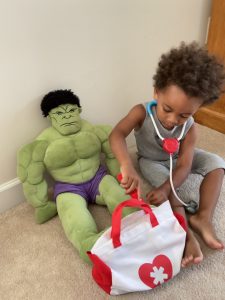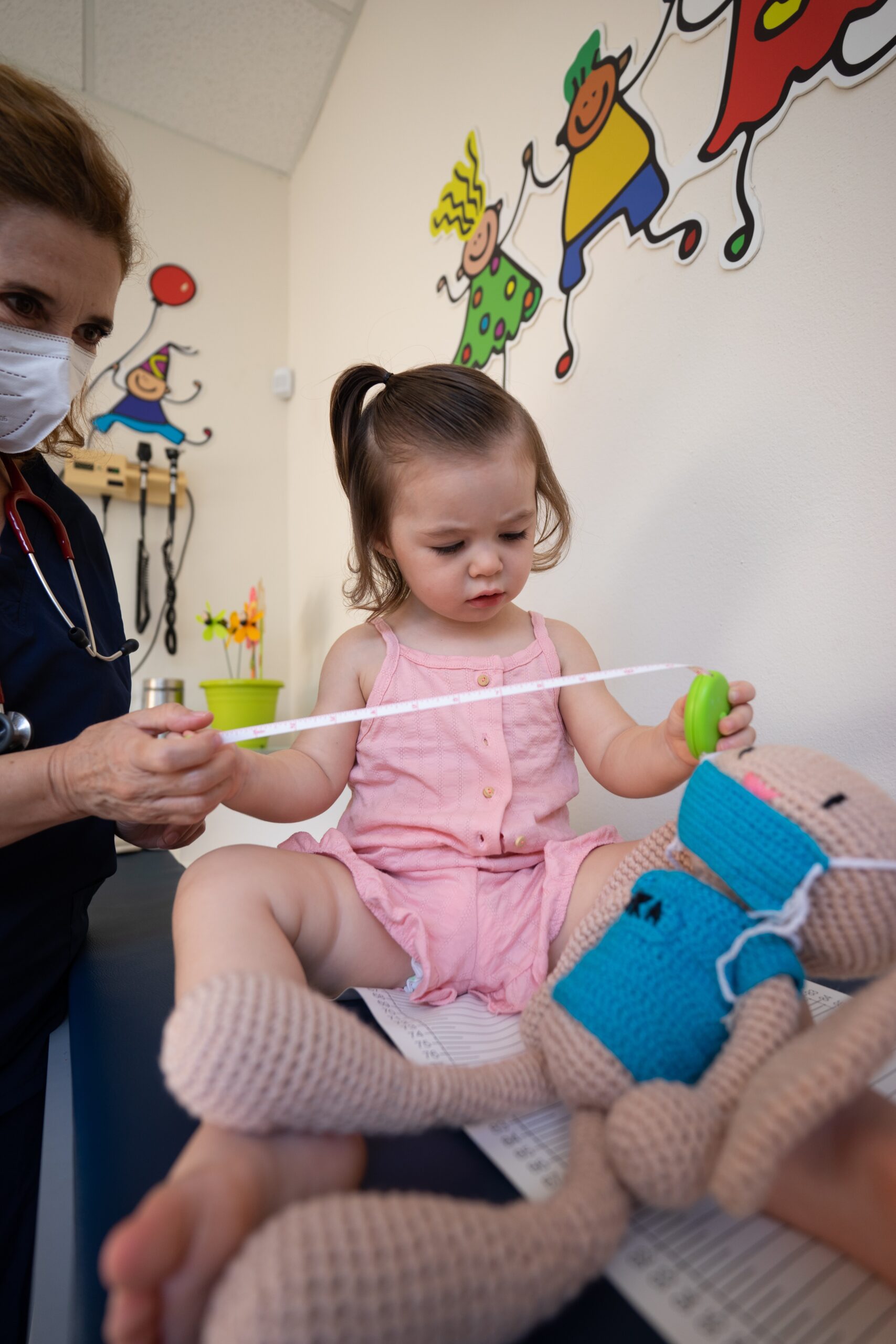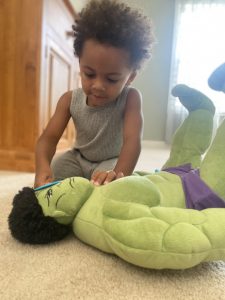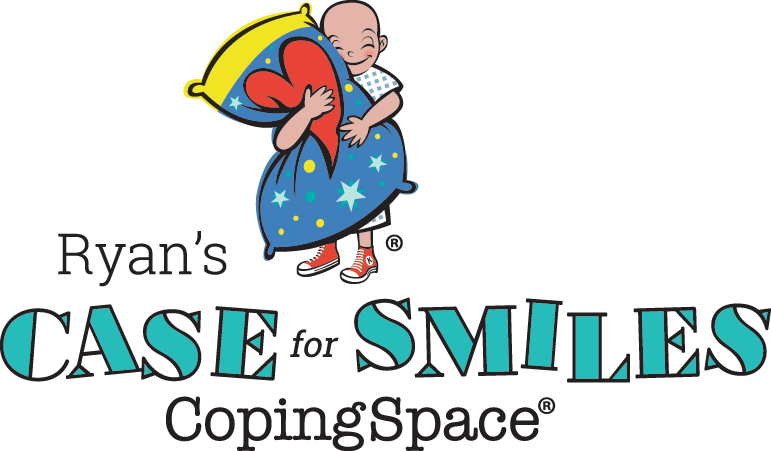BLOG
Teddy Bear Clinics: Helping Kids Overcome Fear of the Doctor with Play
 Does your child dread going to the doctor? Are they anxious every time they need another medical test or procedure? One of the hardest parts of caregiving is making your children do hard, but necessary things. Even worse is when you feel powerless to ease their fears. And when your child has a life-changing illness or injury, life can feel like an endless chain of doctors visits and anxiety.
Does your child dread going to the doctor? Are they anxious every time they need another medical test or procedure? One of the hardest parts of caregiving is making your children do hard, but necessary things. Even worse is when you feel powerless to ease their fears. And when your child has a life-changing illness or injury, life can feel like an endless chain of doctors visits and anxiety.
If this sounds like your child, you’re not alone. In fact, in a C.S. Mott Children’s Hospital National Poll about half of parents of children ages 2-5 reported their child is afraid of going to the doctor. But there is something simple you can do to help – play pretend. In fact, playing doctor is a practice regularly used in many hospitals and clinics by child life specialists. They call it a teddy bear clinic.
What Is A Teddy Bear Clinic?
 A teddy bear clinic is a fun way for children to reduce their fears by giving their stuffed animals the care they have had, or will receive, from their healthcare team. Typically best for ages 1-12, teddy bear clinics empower a child to take control of the situation, a rare occurance for many throughout the healthcare experience.
A teddy bear clinic is a fun way for children to reduce their fears by giving their stuffed animals the care they have had, or will receive, from their healthcare team. Typically best for ages 1-12, teddy bear clinics empower a child to take control of the situation, a rare occurance for many throughout the healthcare experience.
Teddy bear clinics are often held at hospitals or clinics by the child life team. However, you too can do it at home to help your child reduce anxiety and cope.
Why Do a Teddy Bear Clinic?
The hospital environment and medical tests and procedures are stressful for any child. The goal of a teddy bear clinic is to reduce their fears and anxiety through familiarity and a sense of control.
Children learn, and express themselves through play, so playing doctor is a powerful tool to normalize a medical experience and help them practice the coping skills they need – all in the safety of home. Children also use what they see during play, so holding a teddy bear clinic can help them process past experiences and resolve common misunderstandings.
Benefits of a Teddy Bear Clinic
There are many benefits to holding a teddy bear clinic, both for your child and for you. Teddy bear clinics can:
- Reduce children’s anxiety and fear of doctor visits and medical procedures
- Promote healthy coping skills
- Provide children with a sense of empowerment
- De-sensitize children to medical equipment
- Help children understand basic medical treatments and healthy habits (like hand washing, sneezing into the elbow, etc)
- Increase a child’s knowledge of their body, health and the hospital
- Create an opportunity for parents to address a child’s questions and concerns
- Minimize children’s distress at doctor’s visits, and therefore improve a caregiver’s ability to share information and ask questions of their medical team
How To Do a Teddy Bear Clinic with Your Child
Holding a teddy bear clinic at home can be as simple as playing pretend. First, gather medical equipment and a few “patients”. These can be stuffed animals, dolls, action figures or even yourself. Commons supplies include a stethoscope, masks, band-aids, syringes, a blood pressure cuff, tape/guaze, tongue depressors, cotton balls, and rubber gloves. Pretend supplies also work if you do not have access to real equipment.
Then, in a comfortable setting while your child is calm, explain that you are going to play doctor and what each piece of equipment is. Use the real names of body parts and medical equipment to help reduce misconceptions or confusion. You can let your child simply explore, or guide the play towards specific procedures and scenarios they encounter in life. Examples include blood pressure checks with a BP cuff, heart checks with a stethoscope, having their temperature taken with a thermomotor, or getting blood drawn.
Hold as many teddy bear clinics as your child wants or needs. You can then repeat the process as new situations or fears arise.
Quick Guide to Holding a Teddy Bear Clinic
To help you get started, below are basic steps and useful phrases to use during your teddy bear clinic. If you are unsure about specific
procedures and terms, speak to your child’s healthcare provider or child life specialist. You can also ask if they have additional situations to practice and other teddy bear clinic ideas.
- Call the child “Doctor” or “Dr. [Name]”, eg Dr. Mary.
- To begin, say “Okay, Dr [Name], your patient is ready.” (Or the name of their stuffed animal).
- Act out various procedures and describe what’s happening using the five senses. For example, “Dr. Billy, do you want me to tell the patient what they might hear in the hospital? Teddy, you may hear some monitors beeping on your IV pole.” Or for an IV insert, “Teddy, I am going to clean your arm, it may feel cold or smell different. Doctor, can you tell Teddy it’s his job to stay very still so we can place his IV?”
- Following each action, explain exactly what is occurring, and why.
- At the end, congratulate the “patient”, and the doctor, for doing a great job.
When to Do a Teddy Bear Clinic
Teddy bear clinics can be used anytime. Just playing with the equipment can be beneficial, allowing a child to explore on their own and simply have fun. More guided play is also great before appointments and procedures to prepare the child with what to expect and practice healthy coping skills. Finally, some children like to re-live an experience to help them process what occurred.
Below are more specific timelines for preparing your child, based on their age.
- Ages 1-3 – For young toddlers, it’s best to begin preparations only one day in advance. Too much advance warning can increase anxiety and lead to misconceptions.
- Ages 3-5 – Older toddlers still need to prepare closer to the experience, about 2 or 3 days and no more than 5 days in advance.
- Ages 6-12 – School-age children can begin to prepare 1-2 weeks beforehand.
- Ages 13 and Up – Typically teenagers are a too old for teddy bear clinics. However, keeping your teen involved throughout the entire experience is important. They should be active participants in decision-making, and therefore can begin preparing as soon as a decision is reached. This helps increase compliance and gives your child a sense of control in a situation where they have very little.
Teddy Bear Clinics in Real Life: Journey’s Story
 Journey was 6 months old when he had his first ear infection. He had continuous reoccurences after that, so his doctors decided he needed tubes around his first birthday. Immediately following surgery, he also required an overnight sleep study, and another surgery one year later.
Journey was 6 months old when he had his first ear infection. He had continuous reoccurences after that, so his doctors decided he needed tubes around his first birthday. Immediately following surgery, he also required an overnight sleep study, and another surgery one year later.
Unfortunately, Journey did not do well in the hospital. He screamed, cried and did not respond well to the anesthesia, which made things more difficult. He was also terrified of his nurses and medical masks. Following surgery, Journey began to wake in the middle of the night screaming. He was so scared, simply hearing someone speak about doctors, shots etc, or even entering office buildings, upset him. It was heartbreaking for his family to watch.
To help, his godmother (who happened to be a child life specialist) got him a doctor’s kit. At first, he was not interested but later, he began playing with and learning about the equipment. His mother and godmother practiced his check-ups and procedures, and soon he loved caring for his toy patients. He even began using the medical kit on his dogs, Poppy and Wella.
Today, Journey’s doctor appointments go much more smoothly. Thanks to the teddy bear clinic, he can identify the equipment, makes the connection with how he plays with his stuffed animals, and understands the medical staff simply want to help. He is a happy 2.5 year old, and when he talks about how his ears now, he smiles.
We wish you equal luck with your teddy bear clinics. And for more information and ways to support your child, visit the Children page.
